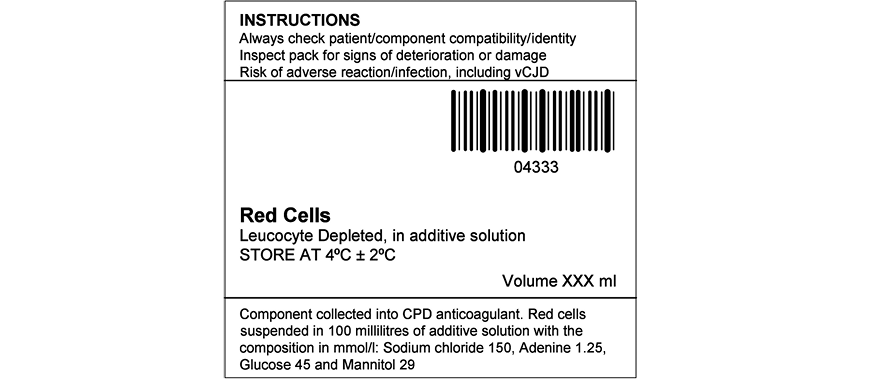23.6: Component labels
23.6.1: General description
These labels are for use on blood collection packs and/or satellite packs. Each label will display a component description printed in bold text, a Codabar barcode and additional information. All information is printed in black on a white background. These labels may be pre-printed or produced using a demand-printed system where the information is transferred electronically from a host system.
23.6.2: Label dimensions
Label dimensions are defined below:
55 mm ±1 mm wide × 55 mm +1/–3 mm deep
(range 54–56 mm wide × 52–56 mm deep)
23.6.3: Label specification
The label must meet the following specifications:
- The barcode height must be no less than 10 mm with a 2 mm quiet zone each side of it.
- The barcode must have the eye-readable code textually displayed to accompany the barcode.
- The textual component description must be in bold characters and be exactly as is registered in the UK portfolio.
- Use of abbreviations must be authorised by the Standing Advisory Committee on Blood Components (SACBC) or JPAC groups.
- A UK JPAC agreed instruction statement must be included.
- The volume of the component must be textually displayed on the label as either the exact or as a nominal volume in millilitres (mL).
- Any storage or special instructions for storage must be included.
- The recipe for any included anticoagulant or additive must be indicated on the label in textual form.
- Where the component is part of a split component, the split should be identified as Pack 1, Pack 2 etc. textually on the label.
- If the component has a reference number (i.e. CT number), it should be included on the label in textual form with or without version number as a suffix.
Figure 23.7 shows an example of a component label layout.
23.6.4: Component barcodes
All components have an individual barcode. The barcode comprises three main elements:
- a start code ‘a0’
- a five-character code to uniquely denote the component
- a stop code ‘3b’.
23.6.5: Component code reference table
The current component code reference table is held and managed by SACIT. The table includes:
- the text defining the component. Where possible this text is the same as that defined in Chapter 7 of these guidelines
- the start code for the component
- the code for the component, e.g. 04260
- the stop code for the component.

Figure 23.7 Example of a component label layout
23.6.6: Allocation of new component codes
In the event of a UK Blood Establishment requiring a code for a component that will be issued on a regular basis, the following steps must be carried out:
- A request form for a new component code, including a component being trialled, must be completed and sent to SACBC. This committee will determine if the component is a ‘new’ component or if it is covered by an existing component registration. If it is a new component it will be reviewed by SACBC members and if agreed, the product will be accepted.
- SACBC will authorise the component to be part of the UK component portfolio and it will then be numbered with a new unused Codabar component code.